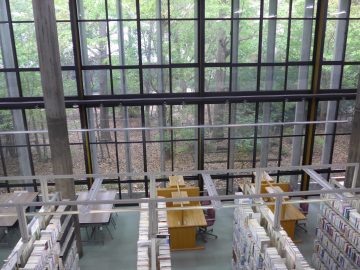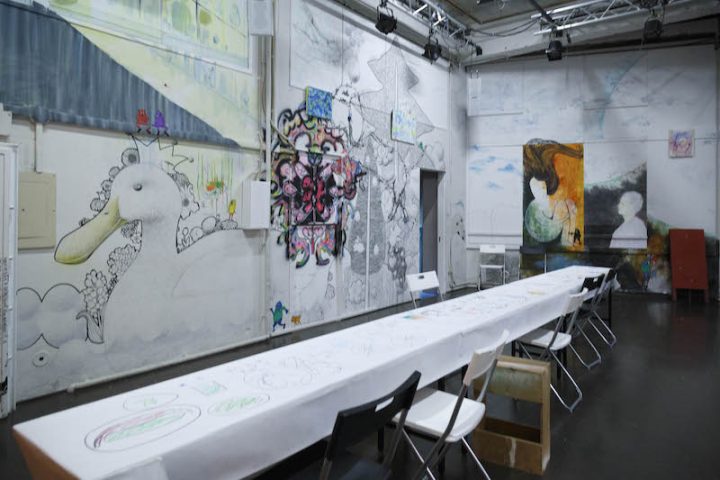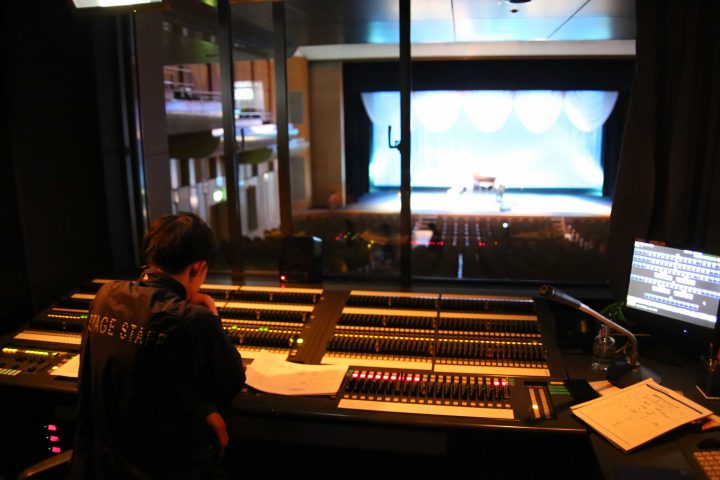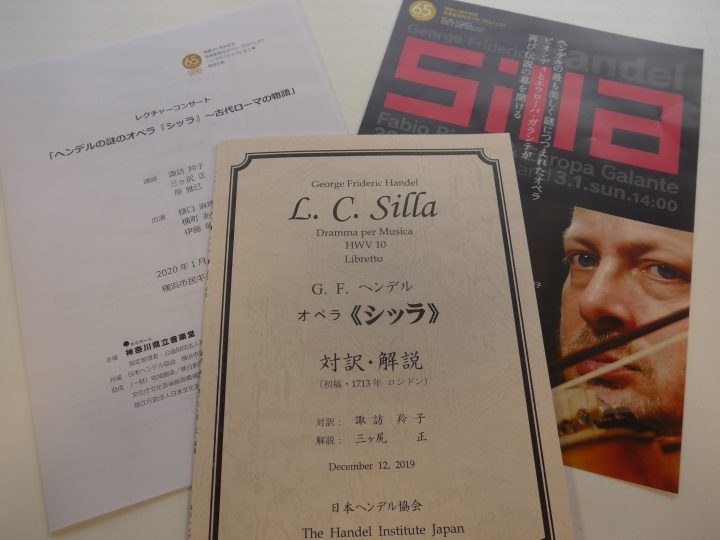EAT&ART TARO is going! “Things related to Tabel” Exhibition ~ Includes retro cooking recipes made by TARO ~
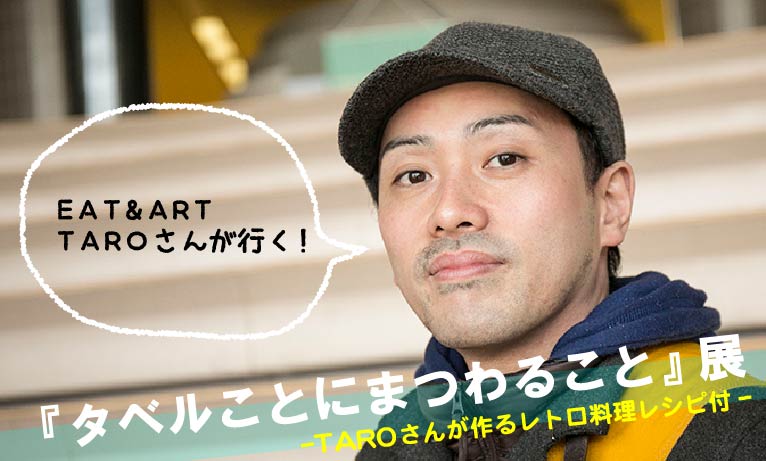
Interview & Text: Akiko Inoue Photo: Masamasa Nishino Cooperation: Kawasaki City Museum
The Kawasaki Civic Museum, located in Nakahara Ward, Kawasaki City, houses a wide variety of works including photography, graphics, manga, art, literature, and video, and presents a variety of exhibits. The current permanent exhibition is called ``Things About Tabel'', which focuses on the act of ``eating'', which is essential for our survival. This time, we welcomed EAT&ART TARO, who is developing art projects with interesting ideas around the theme of "food," as a guest, and together we toured the exhibition rooms divided into seven themes. In the final exhibition room, you will find a corner dedicated to one of TARO's works, ``Retro Cooking.''
This time, TARO specially did some retro cooking. The menu item is ``Spaghetti Milano'' from ``Restaurant Pony'' (founded in 1955, sadly closed in 2012) in Bashamichi, Yokohama. For recipes you are interested in, please go to P2 )
Now, I would like to take a look around the exhibition hall with TARO.
The first theme is ``Arawas'', and works with food as a motif are on display. One of the most innovative works is Ippei Okamoto's Tsujigiri (1916). A passerby who was walking while eating a watermelon was slashed in the abdomen with a sword, and the cut section of the stomach was also a watermelon.
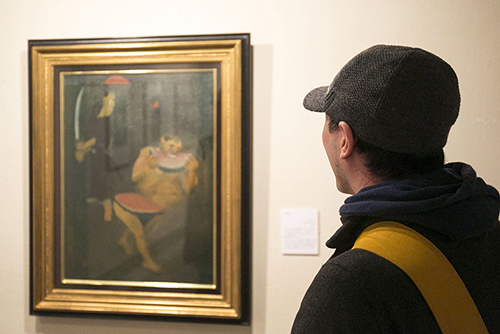
Interviewer (omitted): Why watermelon?
TARO (hereinafter referred to as T) : I wonder why...but isn't it better to make it into a cross section first?
This is what it would be like if I cut the watermelon and cut the belly... (lol)
The setting sun behind me definitely reminds me of a watermelon.![]()
The next theme, ``Iwau Koto,'' brought together works related to food at various annual events. As mentioned earlier, Ippei Okamoto's work ``Humor Karuta'' is, as the name suggests, a karuta filled with the humor of the time.
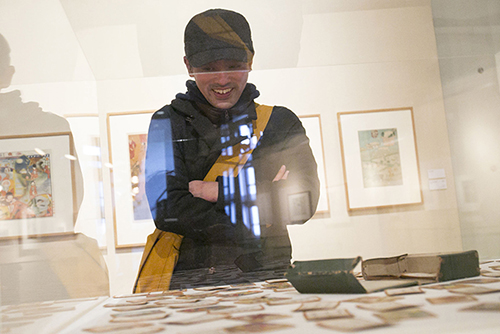
T : (Looking at the karuta and thinking) “Anpan niha hesogaalu…”
-The navel is something like a perilla in the middle.
T : Kimuraya's anpan is made from salted cherry blossoms.
I was a little curious, so I looked into the "belly button" of red bean buns. It is said that this anpan was originally given as a gift to Emperor Meiji in order to differentiate it from other types of anpan. If you are interested, please click here .
By the way, the "na" in this Humor Karuta was "Napoleon Shimanagashi," and even though it's a karuta with the image of children playing, the words were chosen with surprising flair and are so funny! Please come and see it at the venue.![]()
The next theme , ``Tsunagel Koto,'' featured photographs depicting the landscapes of rural Japan before the 1960s. ``Nowadays, when you go to the market, you'll see cardboard boxes piled up like huge buildings, but back then they didn't have anything like that, so they used straw for packaging,'' says TARO. Sumi Sonobe's Cabbage Shipment (1957) depicts a man taking a nap in a field stacked with cabbages wrapped in straw. The things we make now and then are the same, but the landscape is changing. I was able to get a sense of a huge history from just one small page of people's lives.![]()
In the next section , ``Yutaka Naru Koto,'' you can see many advertisements from the 1980s in Japan. The 1980s was a time of rapid economic growth, when people's lives began to change significantly. I could see that advertising was gaining momentum, as if reflecting the era of mass production and mass consumption.

T: "It's amazing to see bright red food on bright red plates. The way the steam rises from it also feels a bit over-the-top."
— ``Ah, China is creeping in.'' The catchphrase has an excellent sense. Kibun's copy is called "Waist Size Story" (lol)
T : Kibun these days seems to be diet-oriented. It says to stop jogging and instead of eating steak, grill some hanpen with margarine (lol).
The display of posters with advertising expressions reminiscent of the times was interesting and full of interesting things to explore, but the corner where old commercials were screened by company and era using nostalgic CRT televisions was also interesting. . I'm sure it will bring a sense of nostalgia to people of a certain generation, and a sense of freshness to people after that.
![]()
Next, displayed across the wall in the same room was a group of works with the theme of ``Tavera Renai,'' which contrasts with the vivid images of food seen in advertisements. By arranging contrasting themes in one exhibition room, the exhibition was designed to appeal to people whether you like it or not. I was taken aback by the words of Mr. TARO, who stood in front of a photo of famine in Africa and murmured, ``It's the 80s, the same era as that advertisement.''
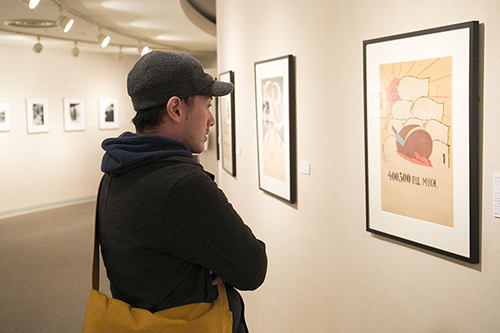
![]()
Continuing with ``Wakachiau Koto,'' whose theme was the places surrounding food, Mariko Kaga's semi-nude photo was also exhibited in ``Onnarasikual Koto,'' an image of a woman depicted in the work. Does it have something to do with food? Some people may think so, but Yoshihiro Tachiki's photo titled ``Private Life Mariko Kaga'' shows a kitchen in the background. Mariko Kaga is still beautiful! !
Next, we finally went to TARO's "Retro Cooking" corner.
On the wall leading to TARO's room, there are some beautiful women... These are the women who grace the cover of retro cookbooks.
■ What is retro cooking? ■
The 1950s to 1950s was a time when TV cooking programs and numerous cooking magazines appeared. We preserve and collect cookbooks from that time, and also hold events where you can actually recreate and cook the recipes from those books. This is an art project by EAT&ART TARO that aims to discover the tastes and food culture of the time.
![]()
As you walk along the wall, admiring the walls lined with retro cookbook covers in chronological order, you will arrive at TARO's room. TARO says, ``I love collecting Showa era cookbooks, so I collect them.'' The covers of Bessatsu Shufu no Tomo from 1930 to 1930 are selected from this valuable collection and arranged in chronological order. It's interesting to see the differences when you line them up like this. Magazine covers are a great resource for understanding the times. Especially since it's a cookbook, it's interesting to see the family circumstances of the time.
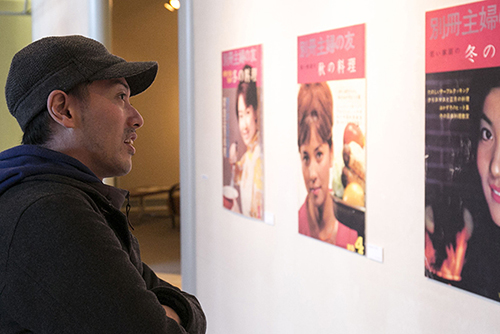
T: By 1955, the dishes featured on the covers began to focus on meat, and the way food was presented changed from small portions to large plates.
-They've already started making sweets with fresh cream here.
T : It says “Sweepstakes/Mixer” on the cover (lol)
As I listened to TARO's explanation, I walked into the room, and there was a room full of retro cookbooks carefully selected from a large collection.
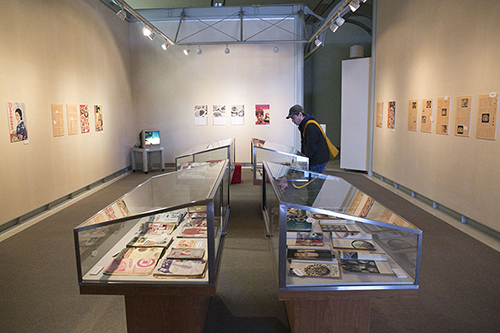
It's also interesting to see how the cooking experts of the time introduced their ideas and arrangements so that they could be made using the equipment and ingredients that were available in the kitchens of the time.

T : For example, what do you think is on the top of this “decorated cake-style sandwich”?
- Normally it would be olive...
T : Yes, I actually wanted to use olives, and my cooking expert also knows about olives.
Even if it says olive, no one can make it, so they think of substitutes. That was Ome.
- Hey!
There were also many other recipes for familiar ingredients that I wanted to try, such as an (innovative) coffee brewing method from the early Showa era, and a decorative egg recipe that makes eggs look like rabbits and apples. It was an exhibition that made me want to see it.![]()
Well, a must-see for those practical people!
This is the retro cooking corner where "Restaurant Pony", which I mentioned at the beginning, will appear. In the exhibition room, there was also a noodle recipe provided by the owner of Pony for a magazine at the time, as well as a video of TARO actually making the recipe.
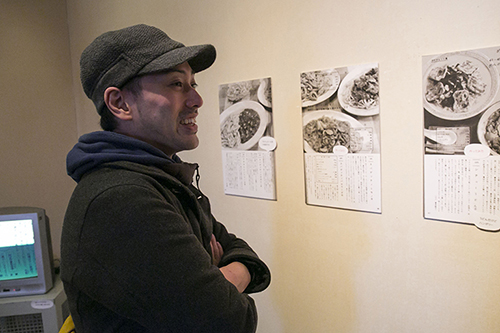
- "Ham Soba" is a menu with a great name.
T : We also have “stew udon” here (lol)
This "Spaghetti Baloise" is spaghetti with minced beef and liver.
It's a sauce based on Hayashiru, but its name is Neapolitan sauce.
-Did Neapolitan mean hayashi sauce at the time? !
T : Nowadays, Neapolitan ketchup is common, but
I think if I made a slight mistake, I might have melted the Hayashiru and turned it into Neapolitan.
I see, according to TARO, Western food began to spread to ordinary households around the 1950s, and since then, various cooking researchers have developed various recipes. Unfortunately, however, there are many recipes that have disappeared without becoming popular, and this ``Spaghetti Baloise'' may be one of them. However, we cannot deny the possibility that some grandmother in some household is still making it, and if that's the case, it can be said to be an excellent food culture. TARO said that it was very interesting to be able to see things like this through his involvement with retro cookbooks.
![]()
Similarly, among the retro recipes of Restaurant Pony, there is a menu called ``Spaghetti Milano''.
The retro recipe is finally here! This was actually created by TARO for MAGCUL.NET. The original story is ``Bessatsu Shufu no Tomo: Autumn Cooking for Young Families'' published in 1968.
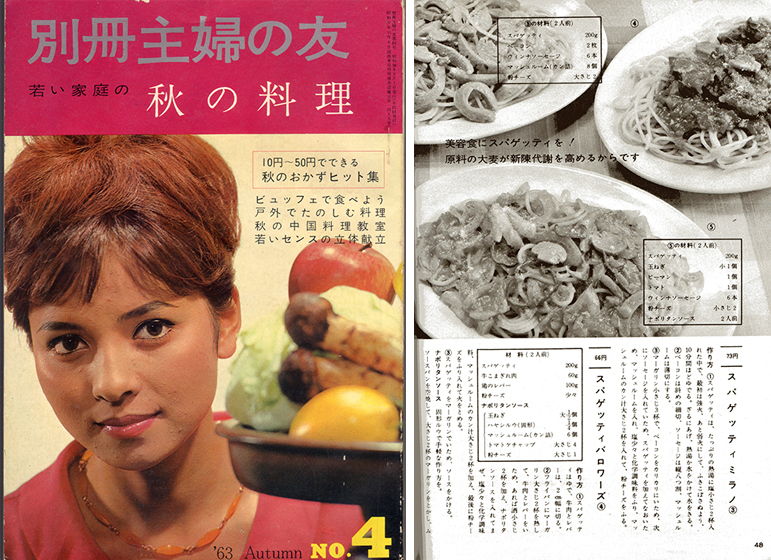
[Steps to make]
By the way, here is the completed photo!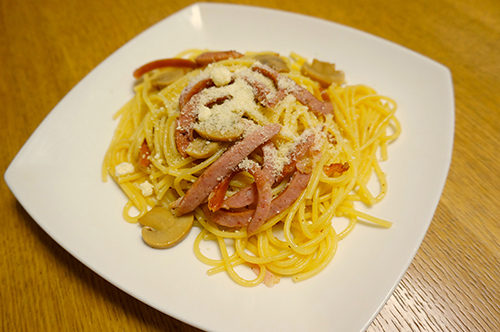
T : This uses bacon and sausage.
-There are no vegetables in it at all.
T : Yes. After doing a little research, I found out that there seems to be a trend of calling meaty dishes Milanese style.
I've come to know that even now, in some regions, Milanese style = ``Ankake''.
Some places call the soy sauce flavor Milanese style, so I don't understand why (lol)
In the chaotic post-war era, Italian restaurants decided to name their dishes after the city name, and it seems that various Milanese styles exist in various places. On the other hand, Napolitan's ketchup-flavored sauce has become popular throughout the country, perhaps thanks to Hotel New Grand. Of course, it is a well-known fact that there is no Napolitan in actual Naples. One of the things I learned through this exhibition is that the power of corporations is greatly involved in the spread of food culture. I felt deeply that the menu items that we take for granted today were actually recipes that were thought up by someone somewhere, and were passed down successfully in some way, changing their forms to become what they are today. At the same time, I became interested in lost recipes that I had never tried before.![]()
This time, I visited the "Things Related to Tabel" exhibition with TARO, and was able to realize the depth of the very familiar act of "eating." Through the retro cookbook, I also became interested in the way food culture spreads, something I had never really thought about before. If you dig deeper into what interests you, you will be able to see the lives of people at that time. And perhaps you will realize that their lives are full of wisdom and playfulness.
I want to know more about retro cooking! If so, please come and join TARO's workshop on February 8th (Sat) at the same venue. There may be stories that could not be written here, or discoveries that no one noticed by actually interacting with the works.
■ Event information ■
“Things related to Tabel” exhibition related projects
“Things related to Tsukuru - Roundtable discussion on recipes”
http://magcul.net/event/kawasaki0208/
Date and time: 2.8 (Sat) 14:00-16:00
Venue: Kawasaki City Citizens Museum Art Gallery
Lecturer: EAT&ART TARO
Participation fee: 300 yen
Application: If applying by fax or email, please write the name, number of participants, address, telephone number, and fax number (if applying by fax) of the participants and send the application to the person in charge of "Tabel Workshop". . FAX: 044-754-4533 Email: 25museum@city.kawasaki.jp
